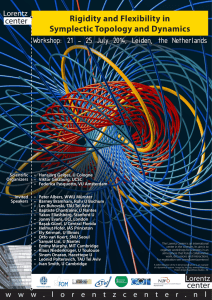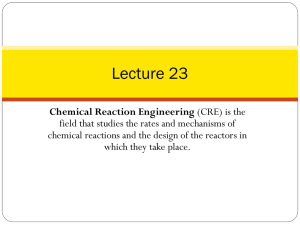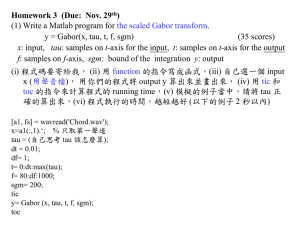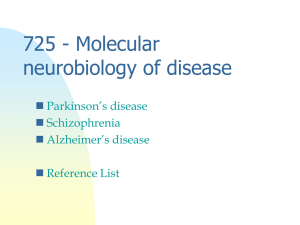Tau as a drug target in Alzheimer`s disease
advertisement
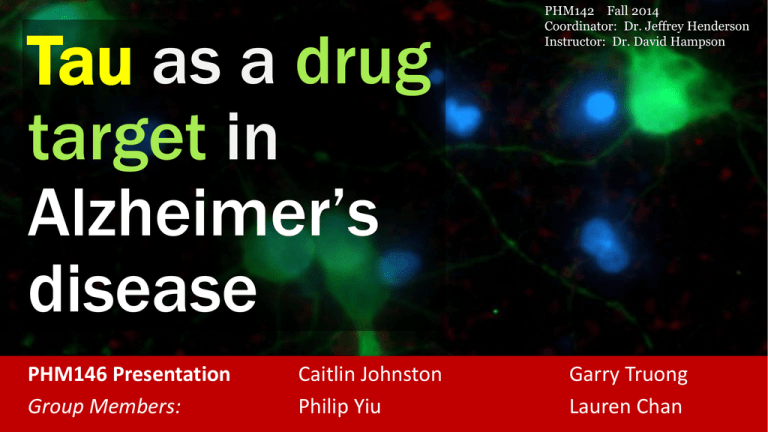
Tau as a drug target in Alzheimer’s disease PHM146 Presentation Group Members: Caitlin Johnston Philip Yiu PHM142 Fall 2014 Coordinator: Dr. Jeffrey Henderson Instructor: Dr. David Hampson Garry Truong Lauren Chan An Introduction to Alzheimer’s Disease (AD) • “Progressive neurodegenerative disorder that leads to dementia” (Buée et al. 2000) Neurofibrillary degeneration dementia death • Functional impairment and loss of neurons leads to decreased memory and other cognitive functions • Two types: 1. Sporadic (SAD): more common, agedependent, genetic and environmental risk factors 2. Familial (FAD): less than 1% of AD patients, result of gene mutations Image source: (American Health Associations’ Alzheimer’s Disease Research) An Introduction to Tau Protein • A part of the Microtubule-associated protein (MAP) family that specializes in the axonal body of the neurons within the brain, but can also be found in dendrites within the CNS • Has a family of six isoforms • Provides stability to the axonal microtubules and facilitates the movement of neuronal impulses Image: Schematic of tau protein (Blennow et. al., 2006) When phosphorylated by kinases, tau dissociates from the microtubules. Conversely, it can be bound to microtubules (MT) through dephosphorylation by a phosphatase. Biological Pathways in AD Image: Aβ precursor protein (APP) and tau processing in neurons (La Ferla, 2008) Tau protein in AD Image: Flowchart of tau hyperphosphorylation and tangle formation (Blennow et. al., 2006) Possible areas of drug targeting 1) Tau hyperphosphorylation 2) Tau aggregation/misfolding 3) Ubiquitination 4) Microtubule disassembly Tau as a drug target: General strategies (Overview) Image: Targets for pharmacological modulation of tau and tau function (Wolfe, 2012) 1) 2) 3) 4) 5) Inhibiting tau hyperphosphorylation Inhibiting tau aggregation/misfolding Increasing tau clearance Targeting microtubule stabilization Immunization strategies Strategy #1: Kinase Inhibitors Image: Targets for pharmacological modulation of tau and tau function (Wolfe, 2012) Note: The focus of this presentation will be on inhibiting tau hyperphosphorylation. 1) 2) 3) 4) 5) Inhibiting tau hyperphosphorylation Inhibiting tau aggregation/misfolding Increasing tau clearance Targeting microtubule stabilization Immunization strategies Strategy #1: Kinase Inhibitors Reduced Neurofibrillary Degeneration Li Strategy #2: Aggregation inhibitors Image: Targets for pharmacological modulation of tau and tau function (Wolfe, 2012) • • Hyperphosphorylated tau aggregates together and blocks proteolysis, leading to cellular stress and causing neural autophagy in AD patients. Example treatment strategy: Small molecules, such as methylene blue, can be used to block the binding between tau molecules and prevent aggregation. Strategy #3: Tau clearance Image: Targets for pharmacological modulation of tau and tau function (Wolfe, 2012) • • Promote the catabolism of tau to (theoretically) reduce tau protein levels Two tau degradation pathways to theoretically target: 1. Ubiquitin-proteasome system (UPS): proteasome stimulators 2. Macroautophagy: autophagy stimulators (targeting tau aggregates) Strategy #4: Microtubule (MT) stabilizers Image: Targets for pharmacological modulation of tau and tau function (Wolfe, 2012) • • • Hyperphosphorylation inhibits the binding that promotes nucleation and growth of MT MT destabilizes causes changes in internal neuron structure, disrupts transport Example treatment strategy: Epothilone D (EpoD) has been shown to reverse effects Strategy #5: Immunization strategies Image: Targets for pharmacological modulation of tau and tau function (Wolfe, 2012) • • Use immune system to clear pathological protein aggregation such as Aβ plaques, but studies have shown that clearing of Aβ plaques may have little to no effect on AD patients. Two approaches: (1) active: introduce foreign antigen resembling tau peptide; (2) passive: introduce antibodies against pathological tau and Aβ. Strategy #5.1: Active Immunization strategies B-cell Tau-like peptide Plasma Cells IMMUNE RESPONSE • Injection of Tau-like peptide into body • T-cell detects the peptide as a foreign threat and initiates an immune response • Downstream of the immune response pathway, anti-tau antibodies are synthesized Strategy #5.1: Active Immunization strategies Image: Targets for pharmacological modulation of tau and tau function (Wolfe, 2012) Reduced Neurofibrillary Degeneration and NFT levels Pathological Tau Strategy #5.2: Passive Immunization strategies Image: Targets for pharmacological modulation of tau and tau function (Wolfe, 2012) Reduced Neurofibrillary Degeneration And NFT levels Pathological Tau • Inject Anti-tau antibodies into the body • Pathological Tau proteins, through an immune response initiated by the Antibodies are eliminated References Blennow, Kaj, Mony J de Leon, and Henrik Zetterberg. “Alzheimer’s Disease.” Lancet 368 (2006): 387–403. Web. LaFerla, Frank M. APP and Tau Processing in Neurons. Digital image. Amyloid-β and tau in Alzheimer’s disease. Nature Review, 2008. Web. 22 Sept. 2014. Buée, L et al. “Tau Protein Isoforms, Phosphorylation and Role in Neurodegenerative Disorders.” Brain research. Brain research reviews 33 (2000): 95–130. Web. Okadaic acid-induced tau-hyperphosphorylation in a primary rat cortex culture. Digital image. Alzheimer's Disease and Tauopathy Cell-Based Assays. Fluofarma, 2013. Web. 22 Sept. 2014. Giacobini, Ezio, and Gabriel Gold. “Alzheimer Disease Therapy--Moving from Amyloid-Β to Tau.” Nature reviews. Neurology 9.12 (2013): 677–86. Web. 31 July 2014. Gong, Cheng-Xin, Inge Grundke-Iqbal, and Khalid Iqbal. “Targeting Tau Protein in Alzheimer’s Disease.” Drugs Aging 27.5 (2010): 351–365. Print. Götz, Jürgen, Arne Ittner, and Lars M Ittner. “Tau-Targeted Treatment Strategies in Alzheimer’s Disease.” British journal of pharmacology 165.5 (2012): 1246–59. Web. 17 Sept. 2014. Himmelstein, Diana S et al. “Tau as a Therapeutic Target in Neurodegenerative Disease.” Pharmacology & therapeutics 136.1 (2012): 8–22. Web. Representation of the brain changes associated with Alzheimer’s Disease. Digital Image. Healthy brain vs. Alzheimer’s brain. American Health Associations’ Alzheimer’s Disease Research. 2014. Web. 22 Wischik, CM et al. “Selective Inhibition of Alzheimer Disease-like Tau Aggregation by Phenothiazines.” Proceedings of the National Academy of Sciences of the United States of America 93 (1996): 11213–11218. Web. 22 Sept. 2014. Wolfe, Michael S. “The Role of Tau in Neurodegenerative Diseases and Its Potential as a Therapeutic Target. Scientifica 796024 (2012): Web. 22 Sept. 2014. Summary Slide • BACKGROUND ON TAU PROTEIN: Tau is part of a Microtubule-associated protein (MAP) family that specializes in the axonal body of the neurons within the brain, but can also be found in dendrites within the CNS • When phosphorylated by kinases, tau dissociates from the microtubules (MT). Conversely, it can be bound to MT through dephosphorylation by a phosphatase. • RELATION TO ALZHEIMER’S DISEASE (AD): One of the causes of AD is the hyperphosphorylation of tau by the overactive kinases, causing rapid breakdown of MT. • High concentration of soluble tau leads to aggregation with each individual tau protein and causes neurofibrillary degeneration by taking up space as a lesion, leading to neuron death and dementia. • THERE ARE FIVE GENERAL STRATEGIES WHEN CONSIDERING TAU AS A DRUG TARGET: GENERAL DRUG TARGETING STRATEGY EXAMPLE 1 Inhibiting tau hyperphosphorylation (e.g. kinase inhibitors) Lithium and Valproic acid (GSK3β Inhibitors) 2 Inhibiting tau aggregation/folding (e.g. aggregation inhibitors) Methylene blue 3 Increasing tau clearance (e.g. protease stimulators, autophagy stimulators) Hsp90 Inhibitors 4 Microtubule stabilization Epothilone D 5 Immunization strategies (e.g. tau antibodies) (In development)
